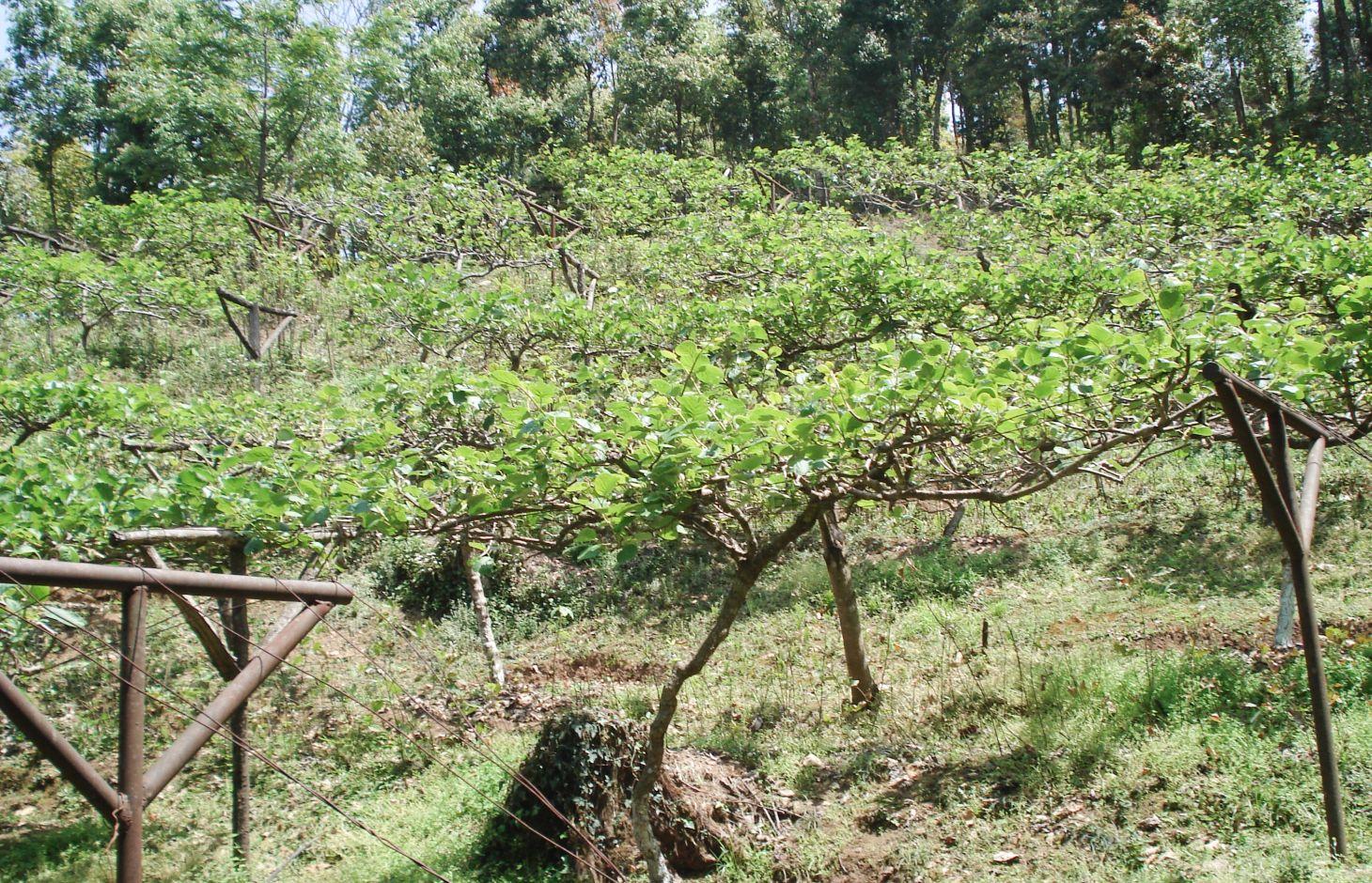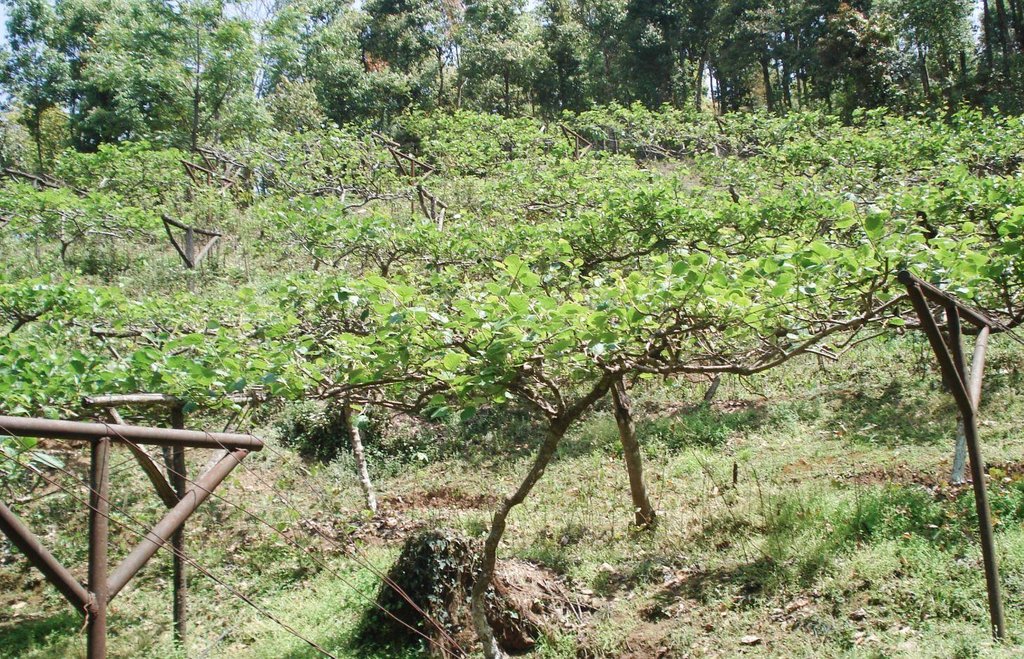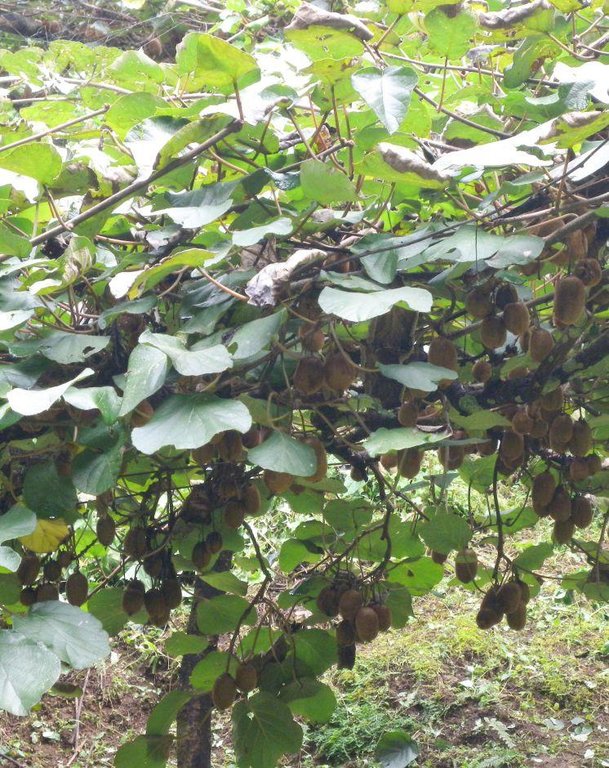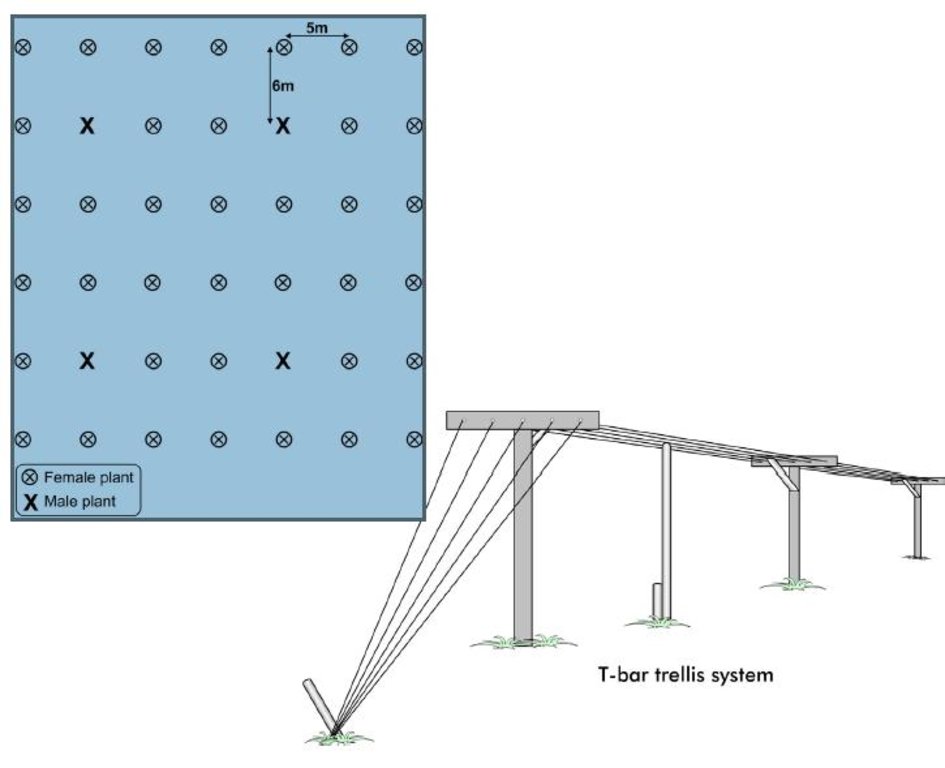Kiwi fruit cultivation [เนปาล]
- ผู้สร้างสรรค์:
- การอัพเดท:
- ผู้รวบรวม: Shreedip Sigdel
- ผู้เรียบเรียง: –
- ผู้ตรวจสอบ: David Streiff, Alexandra Gavilano
kiwi (theki) fal kheti (Main Contributor: Samden Sherpa, ICIMOD)
technologies_1686 - เนปาล
ดูส่วนย่อย
ขยายทั้งหมด ย่อทั้งหมด1. ข้อมูลทั่วไป
1.2 รายละเอียดที่ติดต่อได้ของผู้รวบรวมและองค์กรที่เกี่ยวข้องในการประเมินและการจัดเตรียมทำเอกสารของเทคโนโลยี
ผู้เชี่ยวชาญ SLM:
Sherpa Samden Lama
ICIMOD
เนปาล
ชื่อขององค์กรซึ่งอำนวยความสะดวกในการทำเอกสารหรือการประเมินเทคโนโลยี (ถ้าเกี่ยวข้อง)
ICIMOD International Centre for Integrated Mountain Development (ICIMOD) - เนปาล1.3 เงื่อนไขการใช้ข้อมูลที่ได้บันทึกผ่านทาง WOCAT
ผู้รวบรวมและวิทยากรหลักยอมรับเงื่อนไขเกี่ยวกับการใช้ข้อมูลที่ถูกบันทึกผ่านทาง WOCAT:
ใช่
2. การอธิบายลักษณะของเทคโนโลยี SLM
2.1 การอธิบายแบบสั้น ๆ ของเทคโนโลยี
คำจำกัดความของเทคโนโลยี:
Kiwi fruit cultivation on sloping land in the mid-hill areas of Nepal can help prevent soil erosion and is a sustainable land management practice. This high value crop introduces biodiversity and improves livelihoods by providing a source of cash income.
2.2 การอธิบายแบบละเอียดของเทคโนโลยี
คำอธิบาย:
The kiwi fruit is native to China. Previously called Chinese gooseberry, it is now more commonly known by its marketing name of kiwi fruit. Kiwi fruits grow on large vines that are similar to grapevines in their general growth and fruiting habits as well as their training and trellising requirements. The fruit normally ripens within 25 weeks after the flowers first appear. The fruits range in weight from 40 to 90 g and can be picked shortly after the first frost in autumn; after that, they can be kept in cold storage for 4–6 months at oC. Kiwi vines can be grown on a wide range of soil types at elevations ranging from 1000 m to 2500 m. The kiwi plant is dioecious, meaning individual plants are either male or female. Only female plants bear fruit, but only when pollinated by a male plant. Vines of both sexes are essential for fruit production, and they must flower at the same time to ensure pollination. One male pollinator vine is required for eight female vines. The vines are commonly supported on sturdy structures strong enough to bear the heavy fruit, which might otherwise break the rather weak vines. T-bars or hitching post trellises are recommended to support the large fruiting area in the form of a canopy and provide easy access to the fruit.
Establishment / maintenance activities and inputs: Seedlings can be planted in the spring as soon as there is little chance of frost. Vines need to be pruned both in summer and in winter to maintain a balance between kiwi plant growth and profitable fruit production. Excessive plant growth is removed during the growing season to keep the kiwi canopy open and to remove non-fruiting wood. Harvesting can begin from the end of November. Frequent weeding is required to reduce competition for moisture and fertilizer. Kiwi fruit requires abundant water; during the dry season the newly planted kiwi vines need deep watering once a week.
2.3 รูปภาพของเทคโนโลยี
2.5 ประเทศภูมิภาค หรือสถานที่ตั้งที่เทคโนโลยีได้นำไปใช้และได้รับการครอบคลุมโดยการประเมินนี้
ประเทศ:
เนปาล
ข้อมูลจำเพาะเพิ่มเติมของสถานที่ตั้ง :
Lalitpur District
ระบุการกระจายตัวของเทคโนโลยี:
- กระจายไปอย่างสม่ำเสมอในพื้นที่
If the Technology is evenly spread over an area, specify area covered (in km2):
0.01
แสดงความคิดเห็น:
Total area covered by the SLM Technology is 0.01 km2.
2.7 คำแนะนำของเทคโนโลยี
ให้ระบุว่าเทคโนโลยีถูกแนะนำเข้ามาอย่างไร:
- ในช่วงการทดลองหรือการทำวิจัย
3. การจัดประเภทของเทคโนโลยี SLM
3.1 วัตถุประสงค์หลักของเทคโนโลยี
- ลด ป้องกัน ฟื้นฟู การเสื่อมโทรมของที่ดิน
- สร้างผลกระทบทางด้านเศรษฐกิจที่เป็นประโยชน์
3.2 ประเภทของการใช้ที่ดินในปัจจุบันที่ได้นำเทคโนโลยีไปใช้

พื้นที่ปลูกพืช
- การปลูกพืชยืนต้นที่ไม่มีเนื้อไม้
- การปลูกไม้ยืนต้น ไม้พุ่ม
Perennial (non-woody) cropping - Specify crops:
- berries
- kiwi
จำนวนของฤดูเพาะปลูกต่อปี:
- 2
แสดงความคิดเห็น:
Major land use problems (compiler’s opinion): When sloping land is not used for agricultural production and not planted with ground cover or other vegetation (such as contour hedgerows), the fertile soil can be eroded and washed away by heavy monsoon rains.
3.5 กลุ่ม SLM ที่ตรงกับเทคโนโลยีนี้
- การปรับปรุงพันธุ์พืชหรือพันธุ์สัตว์ต่าง ๆ
3.6 มาตรการ SLM ที่ประกอบกันเป็นเทคโนโลยี

มาตรการอนุรักษ์ด้วยวิธีพืช
- V1: ต้นไม้และพุ่มไม้คลุมดิน
3.7 รูปแบบหลักของการเสื่อมโทรมของที่ดินที่ได้รับการแก้ไขโดยเทคโนโลยี

การกัดกร่อนของดินโดยน้ำ
- Wt (Loss of topsoil): การสูญเสียดินชั้นบนหรือการกัดกร่อนที่ผิวดิน

การเสื่อมโทรมของดินทางด้านเคมี
- Cn (Fertility decline): ความอุดมสมบูรณ์และปริมาณอินทรียวัตถุในดินถูกทำให้ลดลงไป (ไม่ได้เกิดจากสาเหตุการกัดกร่อน)
แสดงความคิดเห็น:
Main causes of degradation: deforestation / removal of natural vegetation (incl. forest fires)
3.8 การป้องกัน การลดลง หรือการฟื้นฟูความเสื่อมโทรมของที่ดิน
ระบุเป้าหมายของเทคโนโลยีกับความเสื่อมโทรมของที่ดิน:
- ลดความเสื่อมโทรมของดิน
4. ข้อมูลจำเพาะด้านเทคนิค กิจกรรมการนำไปปฏิบัติใช้ ปัจจัยนำเข้า และค่าใช้จ่าย
4.1 แบบแปลนทางเทคนิคของเทคโนโลยี
ข้อมูลจำเพาะด้านเทคนิค (แบบแปลนทางเทคนิคของเทคโนโลยี):
Above: Layout of a kiwi orchard. The ideal density of kiwi plants in an orchard is 300 per ha, or in terms of the units of measure commonly used in Nepal, 15 plants per ropani. The plants are spaced 6 m apart and the distance between the rows is 5 m, with a male to female plant ratio of 1:8.
Below: T-bars are used as trellis supports for the kiwi vines. The T-bars are 2.5–3 m long iron posts that are anchored into the ground; they extend approximately 1.8 m above the ground and 60–70 cm deep into the soil. The arms of the T-bar extend 1–1.2 m. The bars are spaced approximately 4.5 m apart with galvanized wire strung between them and pulled taught to form the trellis itself. The end posts are braced by 4–5 wires that are secured into the ground (as shown).
The kiwi plants should be at least
0.6 m away from the T-bars. The centre wire supports the main cordons, and the outer wires support the fruiting lateral parts.
Technical knowledge required for field staff / advisors: moderate
Technical knowledge required for land users: moderate
Main technical functions: improvement of ground cover, increase of biomass (quantity), Reduce soil erosion
Secondary technical functions: control of concentrated runoff: impede / retard, reduction of slope angle
ผู้เขียน:
AK Thaku
4.2 ข้อมูลทั่วไปเกี่ยวกับการคำนวณปัจจัยนำเข้าและค่าใช้จ่าย
ให้ระบุว่าค่าใช้จ่ายและปัจจัยนำเข้าได้รับการคำนวณอย่างไร:
- ต่อพื้นที่ที่ใช้เทคโนโลยี
ระบุขนาดและหน่วยพื้นที่:
ha
ระบุสกุลเงินที่ใช้คำนวณค่าใช้จ่าย:
- USD
ระบุค่าเฉลี่ยของค่าจ้างในการจ้างแรงงานต่อวัน:
3.7
4.3 กิจกรรมเพื่อการจัดตั้ง
| กิจกรรม | Timing (season) | |
|---|---|---|
| 1. | • The plot where the vines are to be planted is prepared by clearing and weeding.• The seedling pits are prepared at least 2 months before planting. Typically the pits are 1 m x 1 m and 1 m deep. The pits are filled with compost (30 kg per pit ) and covered with soil to a height of 0.3 m above the ground. | 2 months |
| 2. | • Seedlings are planted in the winter to the same depth as in the nursery; they are planted 6 m apart in rows spaced 5 m apart.• The plants are pruned back to single, healthy shoots 15–30 cm high. |
4.4 ค่าใช้จ่ายของปัจจัยนำเข้าที่จำเป็นสำหรับการจัดตั้ง
| ปัจจัยนำเข้า | หน่วย | ปริมาณ | ค่าใช้จ่ายต่อหน่วย | ค่าใช้จ่ายทั้งหมดต่อปัจจัยนำเข้า | %ของค่าใช้จ่ายที่ก่อให้เกิดขึ้นโดยผู้ใช้ที่ดิน | |
|---|---|---|---|---|---|---|
| แรงงาน | Prepare pits and seedlings | persons/day/ha | 136.0 | 3.6765 | 500.0 | |
| วัสดุด้านพืช | Planting material | ha | 1.0 | 1500.0 | 1500.0 | |
| ปุ๋ยและสารฆ่า/ยับยั้งการเจริญเติบโตของสิ่งมีชีวิต (ไบโอไซด์) | Compost / manure | ha | 1.0 | 150.0 | 150.0 | |
| วัสดุสำหรับก่อสร้าง | Iron pole | ha | 1.0 | 3500.0 | 3500.0 | |
| ค่าใช้จ่ายทั้งหมดของการจัดตั้งเทคโนโลยี | 5650.0 | |||||
| Total costs for establishment of the Technology in USD | 5650.0 | |||||
4.5 การบำรุงรักษาสภาพหรือกิจกรรมที่เกิดขึ้นเป็นประจำ
| กิจกรรม | ช่วงระยะเวลา/ความถี่ | |
|---|---|---|
| 1. | Permanent sod is maintained between the plant rows. Frequent weeding is required especially during the rainy season.• Both summer and winter pruning is required. | |
| 2. | • Cuttings from branches that fruited during the previous season (typically less than a pencil width in thickness) are collected during the winter pruning for propagation.• Overhead sprinkler irrigation is used for commercial kiwi production.• Kiwi vines are fertilized with manure in the early spring |
4.6 ค่าใช้จ่ายของปัจจัยนำเข้าและกิจกรรมที่เกิดขึ้นเป็นประจำที่ต้องการการบำรุงรักษา (ต่อปี)
| ปัจจัยนำเข้า | หน่วย | ปริมาณ | ค่าใช้จ่ายต่อหน่วย | ค่าใช้จ่ายทั้งหมดต่อปัจจัยนำเข้า | %ของค่าใช้จ่ายที่ก่อให้เกิดขึ้นโดยผู้ใช้ที่ดิน | |
|---|---|---|---|---|---|---|
| แรงงาน | Maintenance and prunning | persons/day/ha | 122.0 | 3.6885 | 450.0 | |
| อุปกรณ์ | Secateurs | ha | 1.0 | 50.0 | 50.0 | |
| อุปกรณ์ | Binding wire | ha | 1.0 | 650.0 | 650.0 | |
| ปุ๋ยและสารฆ่า/ยับยั้งการเจริญเติบโตของสิ่งมีชีวิต (ไบโอไซด์) | Compost / manure | ha | 1.0 | 150.0 | 150.0 | |
| ค่าใช้จ่ายทั้งหมดของการบำรุงรักษาสภาพเทคโนโลยี | 1300.0 | |||||
| Total costs for maintenance of the Technology in USD | 1300.0 | |||||
4.7 ปัจจัยสำคัญที่สุดที่มีผลกระทบต่อค่าใช้จ่าย
ปัจจัยสำคัญที่สุดที่มีผลกระทบต่อค่าใช้จ่ายต่างๆ:
The above establishment cost is for a plantation of 300 plants on one hectare; the recurrent annual maintenance cost has been calculated for a plantation of 300 plants per ha per year. All costs are estimated based on experience gained at the ICIMOD Knowledge Park at Godavari.
5. สิ่งแวดล้อมทางธรรมชาติและของมนุษย์
5.1 ภูมิอากาศ
ฝนประจำปี
- < 250 ม.ม.
- 251-500 ม.ม.
- 501-750 ม.ม.
- 751-1,000 ม.ม.
- 1,001-1,500 ม.ม.
- 1,501-2,000 ม.ม.
- 2,001-3,000 ม.ม.
- 3,001-4,000 ม.ม.
- > 4,000 ม.ม.
เขตภูมิอากาศเกษตร
- กึ่งชุ่มชื้น
Thermal climate class: subtropics
5.2 สภาพภูมิประเทศ
ค่าเฉลี่ยความลาดชัน:
- ราบเรียบ (0-2%)
- ลาดที่ไม่ชัน (3-5%)
- ปานกลาง (6-10%)
- เป็นลูกคลื่น (11-15%)
- เป็นเนิน (16-30%)
- ชัน (31-60%)
- ชันมาก (>60%)
ธรณีสัณฐาน:
- ที่ราบสูง/ที่ราบ
- สันเขา
- ไหล่เขา
- ไหล่เนินเขา
- ตีนเนิน
- หุบเขา
ระดับความสูง:
- 0-100 เมตร
- 101-500 เมตร
- 501-1,000 เมตร
- 1,001-1,500 เมตร
- 1,501-2,000 เมตร
- 2,001-2,500 เมตร
- 2,501-3,000 เมตร
- 3,001-4,000 เมตร
- > 4,000 เมตร
5.3 ดิน
ค่าเฉลี่ยความลึกของดิน:
- ตื้นมาก (0-20 ซ.ม.)
- ตื้น (21-50 ซ.ม.)
- ลึกปานกลาง (51-80 ซ.ม.)
- ลึก (81-120 ซ.ม.)
- ลึกมาก (>120 ซ.ม.)
เนื้อดิน (ดินชั้นบน):
- ปานกลาง (ดินร่วน ทรายแป้ง)
อินทรียวัตถุในดิน:
- สูง (>3%)
(ถ้ามี) ให้แนบคำอธิบายเรื่องดินแบบเต็มหรือระบุข้อมูลที่มีอยู่ เช่น ชนิดของดิน ค่า pH ของดินหรือความเป็นกรดของดิน ความสามารถในการแลกเปลี่ยนประจุบวก ไนโตรเจน ความเค็ม เป็นต้น:
Soil fertility is medium
Soil drainage / infiltration is medium
Soil water storage capacity is medium
5.4 ความเป็นประโยชน์และคุณภาพของน้ำ
ระดับน้ำใต้ดิน:
<5 เมตร
น้ำไหลบ่าที่ผิวดิน:
ดี
คุณภาพน้ำ (ที่ยังไม่ได้บำบัด):
เป็นน้ำเพื่อการดื่มที่ดี
ความคิดเห็นและข้อมูลจำเพาะเพิ่มเติมเรื่องคุณภาพและปริมาณน้ำ:
Water quality (untreated): Also for agricultural use (irrigation)
5.5 ความหลากหลายทางชีวภาพ
ความหลากหลายทางชนิดพันธุ์:
- สูง
ความคิดเห็นและข้อมูลจำเพาะเพิ่มเติมของความหลากหลายทางชีวภาพ:
695 species of flora and 230 species of fauna have been documented within the Knowledge Park's 30 ha area
5.6 ลักษณะของผู้ใช้ที่ดินที่นำเทคโนโลยีไปปฏิบัติใช้
แนวทางการตลาดของระบบการผลิต:
- mixed (subsistence/ commercial)
รายได้ที่มาจากนอกฟาร์ม:
- > 50% ของรายได้ทั้งหมด
ระดับของการใช้เครื่องจักรกล:
- งานที่ใช้แรงกาย
- การใช้กำลังจากสัตว์
ระบุลักษณะอื่นๆที่เกี่ยวข้องของผู้ใช้ที่ดิน:
Population density: < 10 persons/km2
5.7 Average area of land used by land users applying the Technology
- < 0.5 เฮกตาร์
- 0.5-1 เฮกตาร์
- 1-2 เฮกตาร์
- 2-5 เฮกตาร์
- 5-15 เฮกตาร์
- 15-50 เฮกตาร์
- 50-100 เฮกตาร์
- 100-500 เฮกตาร์
- 500-1,000 เฮกตาร์
- 1,000-10,000 เฮกตาร์
- >10,000 เฮกตาร์
5.8 กรรมสิทธิ์ในที่ดิน สิทธิในการใช้ที่ดินและสิทธิในการใช้น้ำ
กรรมสิทธิ์ในที่ดิน:
- รัฐ
สิทธิในการใช้ที่ดิน:
- เกี่ยวกับชุมชน (ถูกจัดระเบียบ)
- รายบุคคล
สิทธิในการใช้น้ำ:
- เกี่ยวกับชุมชน (ถูกจัดระเบียบ)
- รายบุคคล
5.9 การเข้าถึงบริการและโครงสร้างพื้นฐาน
ถนนและการขนส่ง:
- จน
- ปานกลาง
- ดี
Labour:
- จน
- ปานกลาง
- ดี
6. ผลกระทบและสรุปคำบอกกล่าว
6.1 ผลกระทบในพื้นที่ดำเนินการ (On-site) จากการใช้เทคโนโลยี
ผลกระทบทางด้านเศรษฐกิจและสังคม
ความเป็นประโยชน์และคุณภาพของน้ำ
ความต้องการน้ำจากการชลประทาน
ผลกระทบด้านสังคมวัฒนธรรมอื่น ๆ
ความมั่นคงด้านอาหาร / พึ่งตนเองได้
แสดงความคิดเห็น/ระบุ:
Kiwi is considered an elite fruit and it is usually too expensive for local consumption
สถาบันของชุมชน
SLM หรือความรู้เรื่องความเสื่อมโทรมของที่ดิน
livelihood and human well-being
แสดงความคิดเห็น/ระบุ:
Kiwi production can be a good source of cash income as it is a high value crop. Kiwi fruit is high in nutrients, eating kiwis has been show to boost the immune system, to help regulate blood pressure, and to be beneficial for cardiac patients
ผลกระทบด้านนิเวศวิทยา
ดิน
สิ่งปกคลุมดิน
การสูญเสียดิน
ความหลากหลายทางชีวภาพของพืชและสัตว์
มวลชีวภาพ/เหนือดินชั้น C
ผลกระทบด้านนิเวศวิทยาอื่น ๆ
Pollen for bees
biodiversity
efficient use of land
competition with other plants for water, nutrients, and sunlight when intercropping
6.2 ผลกระทบนอกพื้นที่ดำเนินการ (Off-site) จากการใช้เทคโนโลยี
น้ำท่วมพื้นที่ท้ายน้ำ
ความสามารถต้านทานการเปลี่ยนแปลง / ความสามารถในการคัดกรอง
6.3 การเผชิญและความตอบสนองของเทคโนโลยีต่อการเปลี่ยนแปลงสภาพภูมิอากาศที่ค่อยเป็นค่อยไป และสภาพรุนแรงของภูมิอากาศ / ภัยพิบัติ (ที่รับรู้ได้โดยผู้ใช้ที่ดิน)
สภาพรุนแรงของภูมิอากาศ (ภัยพิบัติ)
ภัยพิบัติทางอุตุนิยมวิทยา
| เทคโนโลยีมีวิธีการรับมืออย่างไร | |
|---|---|
| พายุฝนประจำท้องถิ่น | ดี |
| พายุลมประจำท้องถิ่น | ไม่ค่อยดี |
ภัยพิบัติจากสภาพภูมิอากาศ
| เทคโนโลยีมีวิธีการรับมืออย่างไร | |
|---|---|
| ภัยจากฝนแล้ง | ไม่ค่อยดี |
ผลลัพธ์ตามมาที่เกี่ยวข้องกับภูมิอากาศอื่น ๆ
ผลลัพธ์ตามมาที่เกี่ยวข้องกับภูมิอากาศอื่น ๆ
| เทคโนโลยีมีวิธีการรับมืออย่างไร | |
|---|---|
| Mild winter frost | ดี |
แสดงความคิดเห็น:
A net canopy can be used to protect the vines from hail storms and help prevent fruit from dropping prematurely
6.4 การวิเคราะห์ค่าใช้จ่ายและผลประโยชน์ที่ได้รับ
ผลประโยชน์ที่ได้รับเปรียบเทียบกับค่าใช้จ่ายในการจัดตั้งเป็นอย่างไร (จากมุมมองของผู้ใช้ที่ดิน)
ผลตอบแทนระยะสั้น:
ด้านบวก
ผลตอบแทนระยะยาว:
ด้านบวกอย่างมาก
ผลประโยชน์ที่ได้รับเปรียบเทียบกับค่าใช้จ่ายในการบำรุงรักษาหรือต้นทุนที่เกิดขึ้นซ้ำอีก เป็นอย่างไร (จากมุมมองของผู้ใช้ที่ดิน)
ผลตอบแทนระยะสั้น:
ด้านบวกเล็กน้อย
ผลตอบแทนระยะยาว:
ด้านบวกอย่างมาก
แสดงความคิดเห็น:
The approximate annual income from kiwi production is USD 11,765/ha/year. The technology provides on-farm employment opportunities for both men and women.
6.5 การปรับตัวของเทคโนโลยี
- ครั้งเดียวหรือเป็นการทดลอง
แสดงความคิดเห็น:
There is a moderate trend towards spontaneous adoption of the Technology
Comments on adoption trend: Kiwi fruit is gaining in popularity in Nepal; at present it is cultivated commercially by farmers in Kavre, Lalitpur, Dolakha, and Ilam Districts as well as in the Kathmandu Valley. The technology is widely accepted. Kiwi saplings were initially supplied by ICIMOD and by a private nursery in Kavre District.
Driver for adoption:
• Increased market demand for kiwi fruit
• A good alternative for sloping land management
• Kiwi cultivation is a source of income generation
Constraints
• It has been difficult to meet the high demand for kiwi seedlings. The scarcity of seedlings is the main bottleneck limiting the uptake of kiwi production.
6.7 จุดแข็ง / ข้อได้เปรียบ / โอกาสของเทคโนโลยี
| จุดแข็ง / ข้อได้เปรียบ / โอกาสในทัศนคติของผู้รวบรวมหรือวิทยากรหลัก |
|---|
|
Orchards are easy to establish and farmers can readily learn what is needed for kiwi cultivation How can they be sustained / enhanced? Awareness and training programmes can help farmers quickly learn what is needed for kiwi cultivation. |
|
The benefits of the technology are easy to observe; farmers generate cash income from selling kiwi fruit, juice, and jam. How can they be sustained / enhanced? Awareness and training programmes can help farmers quickly learn what is needed for kiwi cultivation and postharvest processing. |
|
Soil erosion is decreased due to increased groundcover. How can they be sustained / enhanced? Awareness and training programmes can help farmers quickly learn what is needed for kiwi cultivation. |
|
Kiwi cultivation provides on-farm employment opportunities. How can they be sustained / enhanced? Awareness and training programmes can help farmers quickly learn what is needed for kiwi cultivation. |
6.8 จุดอ่อน / ข้อเสียเปรียบ / ความเสี่ยงของเทคโนโลยีและวิธีการแก้ไข
| จุดอ่อน / ข้อเสียเปรียบ / ความเสี่ยงในทัศนคติของผู้รวบรวมหรือวิทยากรหลัก | มีวิธีการแก้ไขได้อย่างไร |
|---|---|
| The initial costs associated with establishing the orchard may be a little expensive for many farmers, these include the purchase of: T-bar trellises, seedlings, iron rods, and wire. | Begin by using locally available materials such as bamboo poles to make T-bar trellis. |
7. การอ้างอิงและการเชื่อมต่อ
7.1 วิธีการและแหล่งข้อมูล
7.3 Links to relevant online information
ชื่อเรื่องหรือคำอธิบาย:
Kiwi fruit production guide. Tuscaloosa, Alabama, United States: Alabama University, Himelrick, DG; Powell, A (1998)
URL:
http://www.aces.edu/pubs/docs/A/ANR-1084/ANR-1084.pdf
ลิงก์และโมดูล
ขยายทั้งหมด ย่อทั้งหมดลิงก์
ไม่มีลิงก์
โมดูล
ไม่มีโมดูล





